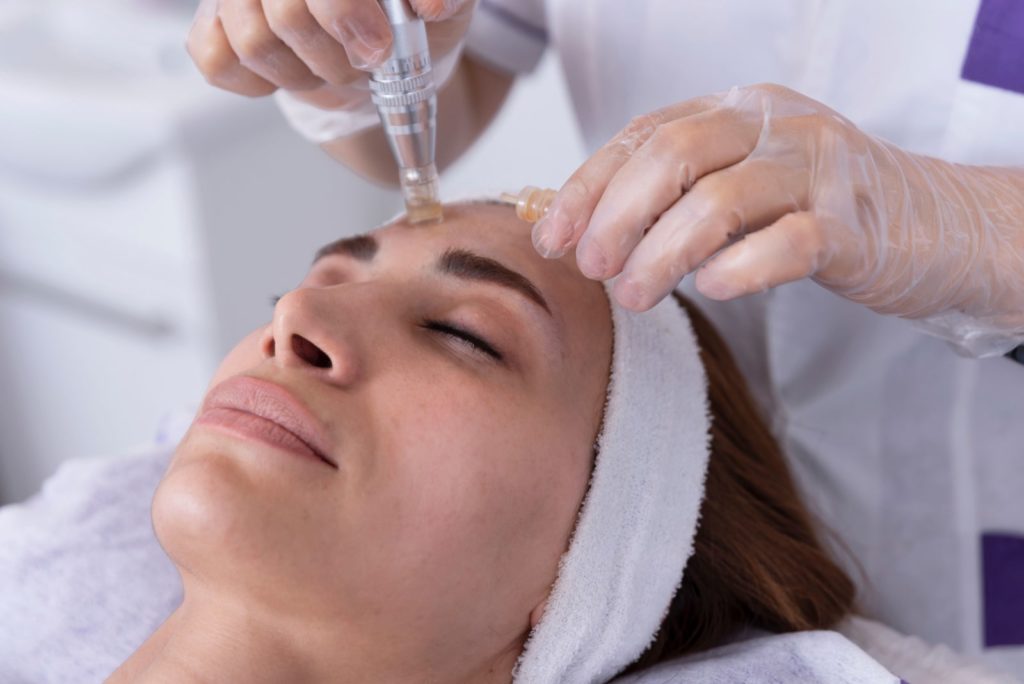In the world of anti-aging aesthetic skin treatments, no one procedure has garnered more buzz than microneedling. And while the noninvasive treatment can dramatically overhaul aging skin from the face on down, there’s still plenty to know about the treatment, especially when it comes to adding on PRP and stem cells, which are standard practice. So, consider this your ultimate guide to microneedling with stem cells versus PRP to determine which is best for you and your skin’s needs.
Stem Cells Vs. PRP: What’s the difference?
During a microneedling treatment, either PRP or stem cells can be used to regenerate and renew the skin further. The main difference between the two (both are applied topically to freshly microneedled skin so that the skin can make better use through the just-open channels) is that PRP relies on plasma to give a boost to the skin and encourage new cell growth, while stem cells replace damaged tissue. PRP, which is faster to perform, is obtained through a blood draw, and the platelets are then spun out in a centrifuge, while stem cells can be obtained from fat or bone marrow which are also separated using a centrifuge. As for stem cells, we use a serum created in the lab. They are not actual live cells. The process of making this product does involve human bone marrow stem cells from donors. The company uses donated cells, then grows and multiplies them. During the culture, the cells secrete all of their regenerative proteins, growth factors, and exosomes into the surrounding media. The lab then collects the solution filled with active ingredients the cells produced and makes it available for use in aesthetic medicine. Stem cells have a tremendous capacity to regenerate new skin cells, collagen, and elastin. Still, the two modalities use factors obtained from your body to help improve the skin while aiding in healing.
Whether you decide to have PRP or stem cells used during your microneedling treatment, both necessitate drawing either blood or stem cells from your body before being placed into a centrifuge to extract either the plasma or stem cells. While each has its specific benefits, stem cells and PRP can improve the skin, specifically scars and loose skin, via collagen production. While stem cells stimulate fibrous tissue to aid in wound healing and up the body’s ability to produce collagen, hyaluronic acid and elastin to reduce the symptoms of rosacea and limit blemishes, age spots, scars, and saggy skin, PRP enhances the skin and treats uneven skin tone, wrinkles, skin laxity, acne scars and even thinning hair and hair loss.
Whether you do microneedling with PRP or stem cell therapy, the treatment is easy and convenient and takes about 30 minutes to perform. Most patients require multiple treatments to reach their skincare goals, but a consultation can determine the best course of treatment for you. There’s also minimal downtime and no recovery with the treatment. So, while the skin may be slightly red or dry post-treatment, you can still go about your routine.
Anyone who is bothered by uneven skin tone and hyperpigmentation, fine lines and wrinkles, sagging skin, and acne scars will benefit from microneedling with PRP or stem cell therapy.
How the Treatment Works
During a microneedling treatment, the skin is first numbed with a topical numbing cream to alleviate potential discomfort. Then, the handpiece is held up to the skin, and the needles quickly and safely penetrate the skin to make pinpoint injuries within the skin without damaging the skin. With the freshly-microneedled skin and channels open, either a solution of PRP or stem cells is rubbed onto the skin to provide even more significant benefits than microneedling alone can provide.
Once the treatment is complete, the micro-injuries left behind will (they can result in pinpoint bleeding from where the needles were inserted) stimulate a cascade of skin-repairing functions over the coming days and weeks. As the skin heals, it will begin to release natural growth factors and trigger the natural wound-healing process, leading to new blood cells, collagen, and elastin. As a result of the healing process, the skin’s texture will improve, and its natural plumpness and elasticity will return. The tone will also improve, lightening dark spots and discoloration and giving the skin a more uniform and younger appearance. Some patients feel an initial tightening after a PRP or stem cell microneedling treatment.
The Results
Like so many other types of regenerative noninvasive skin treatments, the results of microneedling are cumulative no matter if PRP or stem cells are used. While some patients may notice improvement after the first treatment, most people require a series of microneedling sessions to reap the full benefits and see a change in their skin.
With the treatments, you can expect to see improved skin health and boosted collagen levels which will help improve the look of:
- Acne scars and other scars
- Fine lines
- Uneven skin texture and tone
- Mild wrinkling
- Skin laxity
- Enlarged pores
- Stretch marks
- Discoloration
Immediately after microneedling with PRP or stem cells, the skin will boast a natural glow, but there may also be some redness and pinpoint bleeding, which quickly goes away. There are short-term benefits with microneedling, like instantly radiant skin that appears healthier, and over time, the skin will appear plumper and firmer with increased elasticity, improved skin tone and texture, and a smoothing effect.
Choosing Between the Two
While both microneedling with PRP and stem cells are efficacious treatments, the best way to determine which one you’ll benefit from most is to schedule a consultation with our team. This way, we can discuss your needs and detail the ins and outs of each therapy to help you make the right decision.
Most patients find that PRP is more effective for treating damaged skin tissue with poor blood supply that affects the skin’s health and appearance, whereas stem cells are more beneficial when the damage is more extreme and long-term. In the end, no matter which therapy you ultimately decide on, the results of both are worth undergoing the treatment and can dramatically change your skin.




